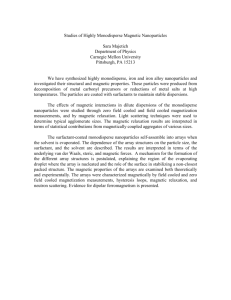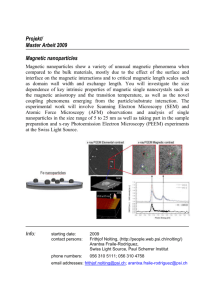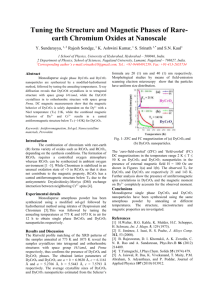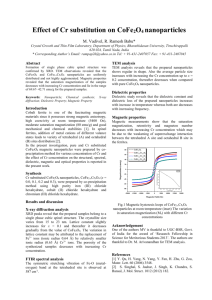Magnetic properties and size distributions of spherical
advertisement
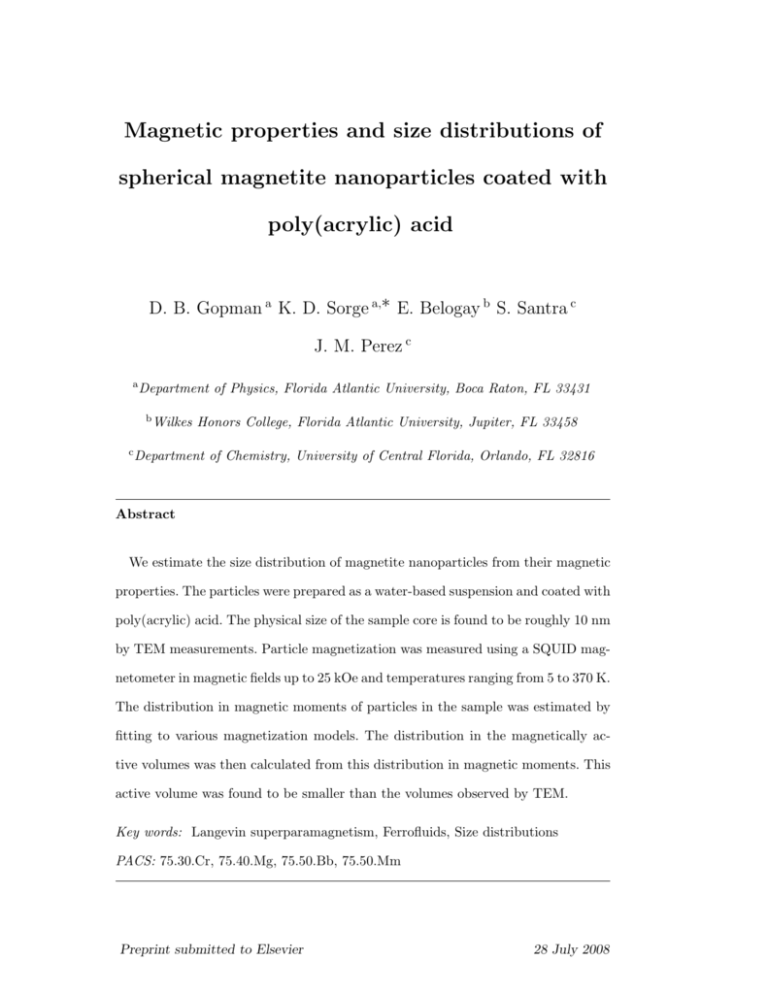
Magnetic properties and size distributions of spherical magnetite nanoparticles coated with poly(acrylic) acid D. B. Gopman a K. D. Sorge a,∗ E. Belogay b S. Santra c J. M. Perez c a Department b Wilkes of Physics, Florida Atlantic University, Boca Raton, FL 33431 Honors College, Florida Atlantic University, Jupiter, FL 33458 c Department of Chemistry, University of Central Florida, Orlando, FL 32816 Abstract We estimate the size distribution of magnetite nanoparticles from their magnetic properties. The particles were prepared as a water-based suspension and coated with poly(acrylic) acid. The physical size of the sample core is found to be roughly 10 nm by TEM measurements. Particle magnetization was measured using a SQUID magnetometer in magnetic fields up to 25 kOe and temperatures ranging from 5 to 370 K. The distribution in magnetic moments of particles in the sample was estimated by fitting to various magnetization models. The distribution in the magnetically active volumes was then calculated from this distribution in magnetic moments. This active volume was found to be smaller than the volumes observed by TEM. Key words: Langevin superparamagnetism, Ferrofluids, Size distributions PACS: 75.30.Cr, 75.40.Mg, 75.50.Bb, 75.50.Mm Preprint submitted to Elsevier 28 July 2008 1 Introduction Recent interest in nanoparticles and ferrofluids has been fueled by their application to medicine. For example, small-scale, low-concentration fluids of superparamagnetic iron oxide nanoparticles (SPIONs) have been investigated for targeted drug delivery [1,2] where medication is functionalized to magnetic particles and delivered directly to target areas. Also, ferrofluid technology is used in localized heating applications [3,4] where a magnetic fluid is heated by a strong oscillating magnetic field. In addition, monodisperse ferrofluids composed of nanoparticles are widely used as contrast agents in imaging [5]. Some of the main biological applications of ferrofluids rely upon a monodisperse sample, either in magnetic resonance regimes [6,5], or in Brownian relaxation measurements [7,8]. Such applications are very sensitive to slight changes in the sizes of suspended particles. In consideration of the sensitive applications using magnetic fluids, efficient techniques for finding physical and magnetic distributions of suspended magnetic nanoparticles in ferrofluids are vital. The current project examines Fe3 O4 nanoparticles coated with poly(acrylic) acid (PAA) and suspended as a water-based colloid. These particles were synthesized as potential nanosensors for molecular interactions in MRI measurements, as described previously [5]. A log-normal distribution in the particle magnetic moment is assumed [7]. By taking a parametric approximation of this log-normal distribution, magnetization measurement are used to find parameters of the distribution. From this, a distribution in particle size is obtained. ∗ Corresponding Author. Email address: sorge@physics.fau.edu (K. D. Sorge). 2 2 Experimental Iron oxide nanoparticles were prepared by mixing an iron salt solution (0.49 g of FeCl3 , 0.21 g of FeCl2 and 88.7 μL of 12(N) HCl in 15 mL of N2 purged water) with an ammonia solution (830 μL of 30% NH4 OH solution in 15 mL of N2 purged water) on a digital vortex mixer, forming a dark suspension of iron oxide nanoparticles. To the resulting suspension of nanoparticles, a solution containing the stabilizing agent (polyacrylic acid) was added (1.0 g of polyacrylic acid in 5 mL of DI water, 0.56 mmol) and then stirred vigorously for 1 hour at 3000 rpm. The solution was then centrifuged at 4000 rpm for 30 min and the supernatant was washed several times with DI water and concentrated through an Amicon 8200 cell to get rid of free polyacrylic acid molecules and other reagents. Two different concentrations of the fluid were investigated (0.9 and 1.9 mg of Fe3 O4 /mL of H2 O) which will be referred to as F0.9 and F1.9, respectively. A vacuum-dried powder of the fluid was also synthesized and analyzed. The hydrodynamic sizes of the polymer-coated nanoparticles were found through dynamic light scattering (DLS) studies. The transverse (T2) proton relaxation times for the nanoparticles were measured using a Bruker Minispec mq20 NMR analyzer operating at a magnetic field of 4.7 kOe and 37◦ C. A histogram of DLS measured sizes was used to compute the actual median and standard deviation. PAA-coated nanoparticles had hydrodynamic sizes within the interquartile range of 82—120 nm with a median of 103 nm. The physical size of the iron oxide cores of the nanoparticles was determined by high-resolution transmission electron microscopy (HRTEM). A drop of 3 nanoparticle solution was placed on a carbon-coated copper grid and dried completely in vacuum to be used as a TEM sample. The TEM image was analyzed using software that counted and estimated the sizes of the particle metal cores. The spherical particles depicted in Fig. 1 exhibited diameters with a right-skewed distribution, in which the middle 50% of diameters ranged from 7.8 nm to 12.7 nm, with median 9.2 nm. As a preparation for magnetic measurements, the fluids were inserted near the center of a glass capillary tube with a long microliter pipette and the ends of the glass tube were sealed with a flame torch. Since the amount of magnetite in the sample is extremely small, each ferrofluid can be assumed as dense as water. All sample tubes were tested for fitness under vacuum and durability during thermal cycling. For comparison, a small mass of the powder was mixed into Duco cement and mounted to a silicon chip. Magnetic measurements were performed in a superconducting quantum interference device (SQUID) magnetometer. Data was taken at temperatures between 5 K and 365 K and fields as high as 25 kOe. Magnetic moment was measured as a function of applied magnetic field at fixed temperatures. 3 Analysis Magnetization curves at fixed temperature were measured on each of the samples. The background susceptibility of the mounting materials in the powder sample was estimated from the high-field susceptibility of the sample and the susceptibility of water in the fluid samples was computed from the nominal volume of water. For clarity, the background susceptibility signal was subtracted from the magnetization data in Fig. 2. These magnetization curves 4 pass through the origin at all but the lowest temperatures measured—a simple signature of the expected superparamagnetic behavior. At 300 K, we find magnetizations of 52 emu/g of Fe3 O4 for fluid samples and 48 emu/g for the powder. Both of these values fall well below the bulk magnetization of magnetite—92 emu/g [9]. These diminished magnetizations have also been observed in similar nanoscale systems [10,11]. For an ideal system of N superparamagnetic particles with magnetic moment μ, we can describe magnetization as a function of field H at fixed temperature T by μH M (H) = N μ L kB T . (1) Here kB is the Boltzmann constant and the Langevin function is given by L(x) = coth(x) − 1/x. Notice that, since L(x) → 1 as x → ∞, the saturation magnetization is Msat = N μ. We refer to this construct as the Simple Langevin Model for a monodisperse sample. The single parameter μ would be found by a curve fit of the data. We tested our sample against the Simple Langevin model for a uniform ensemble of magnetic moments. Using nonlinear least-squares optimization, we found the magnetic moment that provides the best fit of the the Simple Langevin Model to the raw magnetization data. As Fig. 3 shows, the single-size model provides a good fit for low and high fields, but a poor fit for moderate fields. Our best fit curve underestimates the background magnetic susceptibility in order to reduce the overall deviation from our data. A distribution of magnetic moment sizes is a more realistic assumption than one of a monodisperse ensemble. The process by which these particles are 5 synthesized often results in a log-normal distribution of particle sizes, which in turn results in a log-normal distribution of particle magnetic moments [12,8,7,13]. Therefore, we assume that the magnetic moments of the nanoparticles have a log-normal distribution with a density given by ln(μ/μ0 )2 f (μ) = , exp − 2σ 2 σμ 2π 1 √ (2) where μ0 is the median moment and σ is the standard deviation of ln(μ/μ0 ). The superposition of the magnetization curves with the log-normal weighting yields the total ensemble magnetization of N superparamagnetic particles of various sizes M (H, T ) = N ∞ 0 μH μL kB T f (μ) dμ. Notice that the saturation magnetization here is Msat = N (3) ∞ 0 μf (μ) dμ = N μ, where μ is the mean moment. The relation between mean and median moment for the log-normal distribution is μ = μ0 exp(σ 2 /2). The ensemble magnetization integral in Eq. (3) has no analytical closed-form and must be computed numerically for each set of parameter values H and T . Since L(x) ≈ x/3 for small x and L(x) → 1 as x → ∞, one can approximate the integral analytically for small and for large values of H [12]. This technique only uses data from the extremes of the measurement range to get distribution parameters. In addition, the limited precision of the actual measurements can lead to unreliable results. In order to ease computation and achieve higher precision, we transform the log-normal distribution to a normal distribution with zero mean and unit standard deviation by the change of variables z = ln(μ/μ0 )/σ. By chosing a uniform and symmetric partition of 15 nodes along the z-axis, spaced at 6 Δz = 0.5, from z = −3.5 to z = 3.5, we are able to approximate the complete integral by breaking it into discrete parts, which can be evaluated for any value of H and T . Instead of using the node values of the normal probability density function (pdf), we used the differences of the cumulative distribution function (cdf) at the nodes as discrete weights against the node values of the Langevin function. We could do so, because the normal cdf of the new variable z can be computed numerically with high precision. As a result, the integral in Eq. (3) is now approximated by the finite weighted sum 7 μn H M (H, T ) = N μn L wn , kB T n=−7 (4) with weights wn = zn +Δz/2 zn −Δz/2 f (z) dz, (5) where zn = nΔz, μn = μ0 exp(zn ), and the weights wn represent the area cen√ tered around each node zn of the normal distribution f (z) = exp(−z 2 /2)/ 2π. This approximation scheme is exact for linear functions in the z variable, so it provides high precision for the Langevin function, which is almost linear at low and high fields. In addition, the simple and natural uniform spacing of nodes in the z variable yields a desirable non-uniform spacing of nodes in the original μ variable, providing more weight at the steepest part of the log-normal density. Finally, we fit this model to data by a non-linear least-squares technique. From this, we find distribution parameters that minimize the sum of the square residuals at all measured field values. As Fig. 4 shows, this model provides a better fit at all field values. In addition, the magnified scale for residuals in 7 Fig. 5 exhibits a nearly five-fold improvement in the quality of fit over that of the Simple Langevin Model. We found the optimal magnetic distribution parameters μ0 = 2.17×10−17 emu and σ = 1.33, by minimizing least-squares error between our experimental data and the discretely-weighted Langevin function, as shown in Eq. (4). The rather large computed value of σ is another indication that our distribution in particle moments is far from monodisperse. Because the magnetic moment of a particle scales with the volume, finding the distribution in moments is a powerful way of characterizing the distribution in physical size for the particles. From TEM images (Fig. 1), we assume that we have spherical particles with volumes given by V = πD3 /6, where D is the particle diameter. If the volumetric magnetization Mvol is assumed to be constant, the median diameter will be given by D0 = (6μ0 /πMvol )1/3 . The standard deviation of this physical size distribution σD is related to the standard deviation in magnetic moment by σD = σ/3. By using a magnetization of Mvol = 250 emu/cm3 and the parameters of our magnetic size distribution, we find that the particle diameter distribution has parameters D0 = 5.5 nm and σD = 0.44 and with quartile range from 4.1 nm to 7.4 nm (Fig. 6). When compared to the TEM data for these particles of D0 = 9.2 nm and σD = 0.33, it implies that not all of the particle is magnetically active. In contrast, the median magnetic size calculated from the best-fit monodisperse magnetic moment is D0 = 9.8 nm, which is high in relation to the sizes measured by TEM (Fig. 6). The calculated distributions of magnetically active diameters are superimposed upon the TEM histogram of core diameters in Fig. 6. The magnetic size 8 distribution is noticeably shifted to lower diameters, relative to the physical size distribution. It is reasonable to assume that a magnetically “dead” layer of atoms is present at the surface of the clusters. A descriptive model for such clusters would consist of a magnetically active core with a concentric “dead” layer of conducting metal-oxide material. Early studies of magnetic thin films attributed magnetic “dead layers” to spin depolarization in the spin tunneling barriers [14]. Spin canting and disorder at the surface of the particles provide another explanation for this size disparity [15,8]. 4 Conclusions We investigated the magnetic properties of water-based ferrofluids of Fe3 O4 nanoparticles coated in poly(acrylic) acid. Both the small particle size and the thick polymeric coating contribute to the superparamagnetic behavior of all samples by precluding agglomeration of magnetic particles in the fluid and maintaining the single domain state of each nanocluster. In all samples, we observed superparamagnetism far below the freezing point of water as well as relatively high saturation magnetization. Using a discrete weighting to the Langevin function and non-linear leastsquares optimization, we were able to find a log-normal distribution of sizes that provided an excellent fit to our raw data. The fact that this fit was at least five times better than the fit based on the single-moment Langevin model clearly indicates that the nanoparticles in the sample did not have the same size — their diameters spread over one order of magnitude. The magnetic sizes calculated from the distribution of magnetic moments 9 were systematically smaller than the physical sizes determined by transmission electron microscopy. Even the most efficient methods of fabrication of similar nanoparticle systems may not be able to stabilize the magnetic outer layers in order to prevent the surface disorder or the existence of a magnetically “dead” layer whose effect was observed in our measurements. In a sense, this dead layer is a “signature” of the chemical synthesis and the geometry of the ensemble. Therefore, determining the distribution of magnetically active volumes remains a relevant method for magnetic characterization. 5 Acknowledgments We would like to thank Mary Beth McEnroe of the Jupiter Medical Center for the donation of the glass capillary tubes and Dr. Christopher Beetle of Florida Atlantic University for his assistance with Maple calculations. References [1] A. Jordan, P. Wust, H. Fahling, W. John, A. Hinz, R. Felix, Int. J. Hyperthermia 9 (1993) 51. [2] V. V. Vaishnava, R. Tackett, A. Dixit, C. Sudakar, R. Naik, G. Lawes, J. Appl. Phys. 102 (2007) 063941. [3] S. Sieben, C. Bergemann, A. Lubbe, B. Brockmann, D. Rescheleit, J. Magn. Magn. Mater. 225 (2001) 175. [4] T. Neuberger, B. Schopf, H. Hofmann, M. Hofmann, B. von Rechenberg, J. Magn. Magn. Mater. 293 (2005) 483. 10 [5] J. M. Perez, F. J. Simeone, A. Tsourkas, L. Josephson, R. Weissleder, Nano Lett. 4 (2004) 119. [6] L. F. Gamarra, G. E. S. Brito, W. M. Pontuschka, E. Amaro, A. H. C. Parma, G. F. Goya, J. Magn. Magn. Mater. 289 (2005) 439. [7] S.-H. Chung, A. Hoffmann, K. Guslienko, S. D. Bader, C. Liu, B. Kay, L. Makowski, L. Chen, J. Appl. Phys. 97 (2005) 10R101. [8] G. F. Goya, T. S. Berquo, F. C. Fonseca, M. P. Morales, J. Appl. Phys. 94 (2003) 3520. [9] B. D. Cullity, Introduction to Magnetic Materials, Addison-Wesley, Reading, MA, 1972. [10] A. K. Gupta, M. Gupta, Biomaterials 26 (2005) 3995. [11] H.-L. Ma, X.-R. Qi, Y. Maitani, T. Nagai, Int. J. Pharm. 333 (2007) 177. [12] R. W. Chantrell, J. Popplewell, S. W. Charles, IEEE Trans. Magn. 14 (1978) 975. [13] N. J. Silva, O. Silva, V. S. Amaral, L. D. Carlos, Phys. Rev. B 71 (2005) 184408. [14] R. P. Borges, W. Guichard, J. G. Lunney, J. M. D. Coey, J. Appl. Phys 89 (2001) 3868. [15] J. M. D. Coey, Phys. Rev. Lett. 27 (1971) 1140. 11 Figure Captions Fig. 1 HRTEM image of Fe3 O4 nanoparticles coated with PAA. Fig. 2 Initial magnetization curves for fluid samples at T = 200 K. Measured magnetic moment is normalized by the volume of ferrofluid. Fig. 3 Assuming a monodisperse sample of magnetic clusters, the best-fit Langevin is successful over low and high field intervals but is deficient over intervals where data was taken under moderate field strength. Fig. 4 The best-fit curve obtained by a log-normal weighting of the Langevin function closely follows the observed data at all field regions. Fig. 5 Comparison of average error and residuals in the Simple and LogNormal Langevin models. The Log-Normal model is five times better. Fig. 6 Histogram of core diameters from TEM (diagonal-shaded) with monodisperse (dotted, shaded) and log-normal (smooth) distribution models of magnetically active diameters. 12 20 nm Fig. 1. 13 F1.9 M (memu / mL H2O) 100 50 0 F0.9 0 5 10 H (kOe) Fig. 2. 14 15 m (µemu) 325 300 275 Raw Data Simple Langevin Model 250 225 0 5 10 15 H (kOe) Fig. 3. 15 20 25 Raw Log-Normal Langevin Moments m (µemu) 325 300 275 250 225 0 5 10 15 H (kOe) Fig. 4. 16 20 25 Average Error (µemu) Residual (µemu) 0.7 0.6 0.5 0.4 0.3 0.2 0.1 0.0 20 Simple Langevin Model 0.51 µemu Log-Normal Langevin Model 0.092 µemu 1 2 10 0 Simple Log-Normal -10 -20 0 5 10 H (kOe) Fig. 5. 17 15 20 25 Fig. 6. 18
